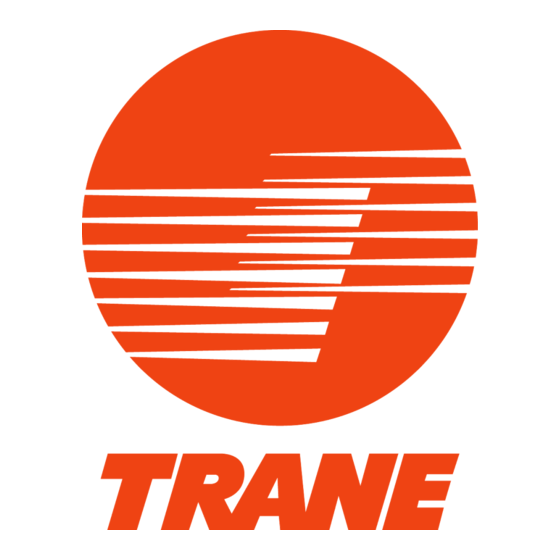Advertisement
Table of Contents
- 1 Table of Contents
- 2 I-Model Number
- 3 II-General Information
- 4 III-Installation Mechanical
- 5 IV-Installation Electrical
- 6 V-Operating Principles
- 7 VI-Controls Interface
- 8 VII-Diagnostics
- 9 VIII-Pre-Start Checkout
- 10 IX-Unit Start-Up Procedures
- 11 X-Periodic Maintenance
- 12 XI-Maintenance Procedures
- 13 XII-Wiring Diagram
- 14 XIII-Standard Conversion Table
- Download this manual
Installation
Operation
Maintenance
Series R Air-Cooled Helical Rotary
Liquid Chillers
RTAC Plus 140 - 350 Ton (60 Hz)
RTAC Plus 140 - 300 Ton (50 Hz)
SAFETY WARNING
Only qualified personnel should install and service the equipment. The installation, starting up, and
servicing of heating, ventilating, and air-conditioning equipment can be hazardous and requires specific
knowledge and training. Improperly installed, adjusted or altered equipment by an unqualified person
could result in death or serious injury. When working on the equipment, observe all precautions in the
literature and on the tags, stickers, and labels that are attached to the equipment.
RTAC-SVX002A-EN
May 2014
Advertisement
Table of Contents

Summarization of Contents
II- General Information
Safety Warnings and Cautions
Important safety notices, warnings, and cautions for proper handling.
Environmental and Refrigerant Practices
Information on environmental impact of refrigerants and responsible handling practices.
Unit Inspection and Handling
Procedures for inspecting and handling the unit upon delivery and installation.
Identification Tag Information
Details on identification tags located on the unit and compressors.
III- Installation Mechanical
Installation Responsibilities and Nameplates
Contractor responsibilities and information on unit nameplates.
Storage and Location Requirements
Procedures for storing the unit and requirements for its installation location.
Isolation, Sound Emission, and Foundation
Methods for isolation, sound emission control, and foundation requirements.
Clearances, Leveling, and Piping
Clearances, leveling, isolator installation, and evaporator piping guidelines.
Strainers, Drain, Flow Switch, and Water Treatment
Importance of strainers, drain, flow switch, and water treatment.
Freeze Protection and Voltage Checks
Measures to prevent freezing and voltage requirements.
IV- Installation Electrical
General Wiring and Safety Precautions
Compliance with codes, capacitor safety, and copper conductor use.
Installer Components and Power Wiring
Components to provide and power wiring guidelines.
Control Power, Heaters, and Interconnections
Details on control power, heaters, interconnections, and pump control.
Low Voltage, External Setpoints, and Communications
Low voltage wiring, external setpoints, and communication interfaces.
Reset Types and Wiring Examples
Chilled water reset types and analog input wiring examples.
V- Operating Principles
Refrigeration Cycle and System Schematic
Explanation of the refrigeration cycle and system overview.
Refrigerant, Compressor, and Condenser Description
Details on R134a refrigerant, compressor, condenser, and subcooler.
Evaporator and Oil System Operation
How the evaporator and oil systems function within the chiller.
VI- Controls Interface
CH530 Control System and DynaView Interface
Overview of the CH530 system, its components, and the DynaView interface.
DynaView Navigation and Screen Functions
How to navigate DynaView screens and use key functions.
Display Screens, Lockout, and Modes
Basic screen format, lockout features, and modes screen.
Chiller, Compressor, and Setpoint Screens
Screens displaying chiller, compressor, and setpoint information.
Diagnostic and Interface Settings
Accessing diagnostics and configuring interface settings.
Active Setpoints and Subscreen Details
Details on active setpoints like chilled water and current limit.
VII- Diagnostics
Connecting to CH530 and Diagnostic Table
How to connect to CH530 and understand the diagnostic table structure.
VIII- Pre-Start Checkout
Pre-Start Installation Checklist
A checklist to verify all installation procedures are completed before unit start-up.
Receiving, Piping, and Electrical Safety
Steps for receiving, piping, and electrical safety precautions.
Voltage, Phasing, and Flow Checks
Checks for unit voltage, phasing, and water system flow.
IX- Unit Start-Up Procedures
Initial Compressor and Refrigerant Start-Up
Procedures for starting the compressor and checking refrigerant.
System Operation and Shutdown Procedures
Steps for system operation, temporary and extended shutdowns.
X- Periodic Maintenance
Periodic Maintenance Schedules
Guidelines for weekly, monthly, and annual maintenance tasks.
XI- Maintenance Procedures
Refrigerant and Oil Charge Management
Importance of proper refrigerant and oil charge for unit performance.
Refrigerant Charging and Isolation Procedures
Steps for charging and isolating refrigerant.
Filter Replacement and Lubrication System
Procedures for filter replacement and understanding the lubrication system.
Oil Charging and Compressor Replacement
Procedures for oil charging and compressor replacement.








Need help?
Do you have a question about the RTAC 250 Series and is the answer not in the manual?
Questions and answers